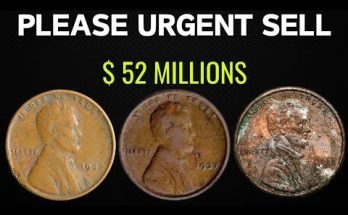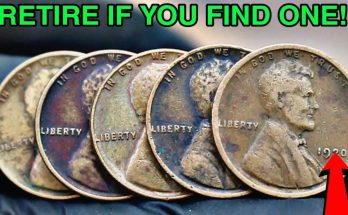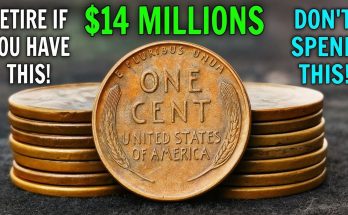The 1943 Penny was a Wheat Cent, named for the design on its tails side. Also, technically, all 1943 Pennies were meant to be Steel Cents aka Steelies. But because it was a transition year, some varieties were coined in bronze, and this drastically raised their prices! So we’re going to look at both these metal compositions as we explore the 1943 Steel Penny Value.
Table of Contents
1943 Steel Penny Value Chart
1943 Steel Penny Specifications
1943 Steel Penny Varieties and Value Guide
Grading 1943 Steel Pennies
1943 Steel Penny Errors List
Additional 1943 Steel Penny Errors
1943 Steel Penny FAQs
1943 Steel Penny Specifications
We often think of the penny as a copper coin. And initially, it was. But in 1857 it had 12% nickel and in 1864 it switched to 5% zinc and/or tin. In both cases, the bulk of the coin was copper. Then in the war years (1942 to 1945), the military needed copper for ammunition and equipment so we switched to steel cents: 99% low-grade carbon steel topped with zinc.
It’s sometimes known as the Steel War Penny, Wartime Cent, Steelie, or Zinc Cent. The zinc plating was intended to prevent rust, but since the top coat was applied to the planchet sheet before punching, that didn’t always work. As the planchet went into the blanking machine to be cut into blank discs, the ungalvanized edges of the coin got exposed by the slicing action.
This meant as the coins circulated, people would touch the edges with sweaty fingers and the moisture would cause these surfaces to rust. Interestingly, steel wasn’t the first alternative they tested. Starting in 1942, the mint experimented with pennies made from fiberglass, plastic, aluminum, lead, tempered glass, hard rubber, white metal, bakelite, and manganese.
Unusual 1943 Pennies
At least one example exists in 86.41% tin with 8.37% antimony. Someone found it in the yard in 1969 and used a vice to straighten it, not knowing it was a priceless rarity! And as we said before, some bronze coins were accidentally minted. Since they’re worth a lot, bronze 1943 pennies are commonly counterfeited by coating steelies in copper. Use a magnet to confirm!
How? Fake 1943 bronze cents will have a steelie underneath, so you can pick them up with a magnet. Conversely, a genuine bronze cent has no iron or steel content so it won’t react to a magnet. Also, weigh the coins. Steelies are 2.7 g while bronze coins are 3.11 g, so with or without copper plating, the difference in mass is a dead giveaway. But back to the steelies.
As we’ve just mentioned, the wartime cent was magnetic, so it stymied counterfeit detectors in vending machines. These machines were built for copper coins, so they were programmed to catch steel fakes aka slugs. And some citizens mistook these steelies for dimes. Steelies were meant to run for the entire war period but due to these issues, they only lasted a year.
Counterfeit Copper Coins
A few steelies were inadvertently minted in 1944 using the same metal mixes and dies as 1943 cents. The rest of the 1944 to 1946 cents were minted on brass planchets made from the salvaged shell casings gathered on the battlefield. This brass was strengthened with pure copper. Many steel cents were recalled and melted by the mint, but some are still circulating.
While the public disliked steel pennies, the mint appreciated their profitability, since their seignorage was way higher than copper/bronze cents. Seignorage is the difference between the production cost and the face value of currency. This price difference provides revenue for the mint. Also, as you collect and sell 1943 Steel Pennies, look out for sneaky coin alterations.
Unscrupulous dealers will sometimes ‘reprocess’ a coin by removing the original zinc coat and adding new zinc and/or chrome. The coin might then be graded as Brilliant Uncirculated (BU) and you might pay more for it if you’re unfamiliar with this practice. We’ll talk more about BU grades later in this article, but first, let’s explore the 1943 Steel Penny’s features.
The Obverse of the 1943 Steel Penny
The obverse (heads side) of the 1943 Steel Penny shows Abraham Lincoln facing right. The motto In God We Trust runs along the rim above his head. On the right, in front of his chest, is the date and mint mark. On the left, behind his back, is the legend Liberty. The designer’s initials, VDB for Victor David Brenner, are on the shoulder cut-off line in Lincoln’s portrait.
The Reverse of the 1943 Steel Penny
The reverse (tails side) of the 1943 Steel Penny features two sheaves of wheat. They’re arranged towards the left and right rims of the coin, framing the legends and mottos on the coin. At the top, E Pluribus Unum runs between the wheat tips, followed by One Cent in a large font. Below the denomination is the legend United States of America in a medium font.
1943 Steel Penny Errors List
Mint errors can raise the investment value of any coin, and at least 20 are listed by Cherry Pickers. The most common ones are doubling or tripling errors when the second or third strike lands on a slightly different spot from the first strike. They happen if the planchet or the die move in mid-strike. Off-center errors are when the planchet shifts before striking.
1943 Steel Penny DDR Error
DDR means doubled-die reverse. It happens when the reverse hub slightly misses its second strike on the die, and the error is repeated on every coin the die strikes. In January 2020, an MS 66 DDR sold for $1,293. PCGS has graded three and estimates their value as $1,300 in 2023. But the highest known grade for DDRs is MS 67, and PCGS has listed two of them.
1943 Steel Penny DDO Error
DDO means doubled-die obverse. It happens when the obverse hub slightly misses its second strike on the die, and the error is repeated on every coin the die strikes. In May 2019, a DDO graded AU Details sold for $5,999 on eBay. And in October 2020, an MS 67 sold for $2,150. Meanwhile, an MS 65 went for $775 in October 2022. PCGS has graded two MS 67+ steelies.
1943 Steel Penny D/D RPM Error
RPM means re-punched mint mark. It’s a doubling or tripling error that happens when the second or third strike of the hand punch hits a slightly different spot. You can see traces of the prior mint mark underneath. RPMs are written as D/D (D over D) or S/S (S over S). In February 2011, an MS 67 was $21,275 and in August 2022, an MS 67+ was only $12,600.
1943/2-S DDO Error
This San Francisco coin has two errors – a doubled-die obverse and an overdate (1943 over 1942). You can see the 2 peeking out below the 3, and the combined error dramatically raises the value of this coin. An MS 67 was auctioned for $10,000 on eBay in October 2022. But PCGS gives a more realistic price estimate of $2,150 for the five MS 67+ coins it has graded.



